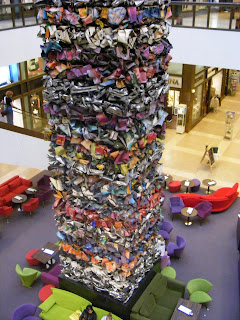I: Around Pariser Platz –
Brandenburg gate: Built in 1791, this is Berlin’s most famous icon, most recent this become the emblematic backdrop of 9th November 1989 when the border was opened and people rushed forward from both sides to scale the defining symbol of the cold war.
Holocaust Denkmal (Memorial to the murdered Jews): completed in May 2005, this forest of concrete slabs is meant to represent the gravestones of Jews murdered under the Nazi regime. It initially provoked much controversy due to its bleak design and the exclusion of graves for non-Jewish victims.
Hotel Adlon: Considered to be the most important society venue in Berlin, the original hotel opened its doors in 1907. The hotel suffered bomb damaged in WW II and was demolished and rebuilt with the same name in 1997. Today it is one of the most luxurious hotels in Berlin.
II: Around Gendarmenmarket
This area shows the country at its most liberal, with the Franzosischer Dom (French Cathedral) on the north side and the similarly proportioned Deutscher Dom on the south side. The Konzerthaus in the centre of the square is one of the earliest buildings designed by the prolific architect, Karl Schinkle.
Freidrichstadt passage – This group of passages is part of a huge development of to luxury shops, offices and restaurants. Quartier 207 is the famous Galleries Lafayette, a French department store occupying a building made almost entirely of glass.
Franzosischer Dom – French Cathedral was built by the Huguenot community, who found refuge in protestant Berlin following expulsion from France. It houses the Huguenots Museum, detailing their history.
Konzerhaus – This theatre is one of the greatest achievements of Berlin’s best know architect Karl Schinkel. Following bomb damage in WWII it was reconstructed as a concert hall and is the home of the Berlin Symphony Orchestra.
Deutscher Dom – This is the old German Protestant reform church. The design was built on a five-petal shape and acquired a dome identical to that of the French cathedral. Burnt down in 1945 the church was rebuilt in 1993 with the interior being adopted as an exhibition space.
IIII: Around Bebelplatz
Once named Opernplatz (Opera square), this area was designed to mirror the grandeur of ancient Rome. On 10th May 1933 this was the scene of the infamous book burning organised by the Nazi propaganda machine.
St Hedwigs Kathedrale – This huge domed cathedral is the Catholic Cathedral of the Roman Archdiocese of Berlin. The crypt below holds the tombs of many famous Berlin Bishops.
Reiterdenkmal Friedrichs des Grossen – The Equestrian statue of Fredrick the great and one of the most famous monuments in Berlin
Humboldt University – This university building was originally built for the brother of Frederick the Great, however it was founded as the university in 1810 by Wilhelm von Humboldt.


















No comments:
Post a Comment